For most modern parents the idea of a floor bed is somehow crazy. Especially in the US where children are kept in cribs until they’re 3, ideally also with a sleep sack on them. Children are not meant to explore on their own during the toddler stage, and especially not during naptime or bedtime.
Montessori philosophy says that everything in the room must be safe for the child to explore on their own, freely, and independently. Everything must be within the child’s reach and at their level. Therefore, a child shouldn’t be restrained by being in the crib and rather sleep in a “big kid” bed.
While the Montessori bed is mostly known as an elaborate house bed as seen on Instagram, let me tell you that the concept is much simpler and unless you want to make it fancy, it doesn’t have to be expensive.
Toddler Floor Bed 101
The floor bed is an extension of the idea that everything a child needs should be accessible and at their level. It gives the children the independence to explore the room, while at the same it teaches them their own body sleeps.
Especially if your little ones are fighting bedtime, a floor bed is a perfect opportunity to learn their own schedule and that the bed is something they can relax in and eventually rest.
That way your kids can easily adjust to new schedules, and routines and won’t be disturbed by having to go to bed for a nap at daycare.

Floor Bed vs Toddler Bed
Do kids really need a toddler bed? You don’t! Toddler beds are basically beds the size of a crib. They’re small – the standard size is 52 inches, so you need to ask yourself how long is it going to last?
My barely 3-year-old is tall and over 40 inches tall. Why would I cramp him on a crib mattress when he could move straight to a twin-size mattress he can use forever? The benefits of having a bigger bed extend to parents too – you can climb in for storytime.
Apart from space saving in a room toddler beds are pointless, because by max. 3.5 years they’re useless and too small for most kids. Especially with siblings around, it’s best to hop in one bed for a book or snuggles and a toddler bed won’t offer enough space.

Pros of Montessori Floor Bed
1. Promotes Freedom of Movement
The height of the bed encourages children to move both on and off the bed with ease. There is no risk of the child falling off a height especially when they are sleepy. This was one of the main reasons why I shifted to the Montessori floor bed before raising it off the floor later on.
2. Encourages Decision Making & Self Discipline
I have found that the floor beds help immensely when it comes to nighttime toilet routines. Since it’s easy to get on and off the bed, my toddler began to have fewer accidents at night. My firstborn was perfectly trained at night at 2.5 years and we transitioned him to the bed at 14 months.
Another surprising aspect that cropped up was about making their bed in the morning. Since the children can access it better, they find it so much easier to put things in place once they get up in the morning.
Most importantly, this floor bed helps the child learn to soothe himself back to sleep if he wakes in the middle of the night without assistance from another person. Toddlers want to make decisions and they don’t need their day to start when parents come to get them out, and instead are empowered to choose how and when to wake and rest.
By 2.5 years my toddler understood that he can wake up and play quietly and come out no earlier than 7 a.m. – thanks to GroClock.
3. Makes Things Easier when Traveling or Changing the Environment
Montessori floor beds help children set up a known environment for themselves. This helps especially if you move around a lot and travel to different hotels or apartments and why we had zero issues using toddler travel beds.
In fact, when I made major moves, I sometimes just rolled a mattress out on the ground and the kids used it till the bed arrived via shipment. With everything that was changing around them, the bed remained one point of consistency.

Cons of Montessori Floor Bed
1. Can Cause Allergies
Carpets and floors are the hardest to keep clean all the time, and having in mind the floor bed’s proximity to them creates a problem. Some kids will be perfectly fine, while others might experience environmental allergies. If that’s the case, a raised bed with rails would be a better option.
2. Might Cause Anxiety for Parents
Some parents might feel anxious about moving the baby too soon, so I will admit that the floor beds are worth it, but they’re just not for everyone. Your child will be just fine, but you might not be 😉
On the bright side, a child trying to climb out of the bed might cause some parents even more anxiety.
Are Montessori Floor Beds Safe?
Are floor beds safe for children who are still learning how to roll over, scoot, and crawl? Yes, as long as everything in their room is babyproofed. Worst case scenario your toddler will end up sleeping on the floor until they learn to go back to bed.
A few times I’ve watched mine on our Nest Cam (we preferred it over the baby monitor), rolled around, explored and played a bit, and then made his way back to bed. No need for our intervention which made the kids more self-aware and responsible.
Honestly, the possibility that a toddler will suffocate on a wall or carpet is next to none, but the possibility of a child falling on their head getting a concussion, or breaking an arm while trying to climb out of the crib is way higher. While sleep sacks are cool they won’t prevent an avid climber, unfortunately.
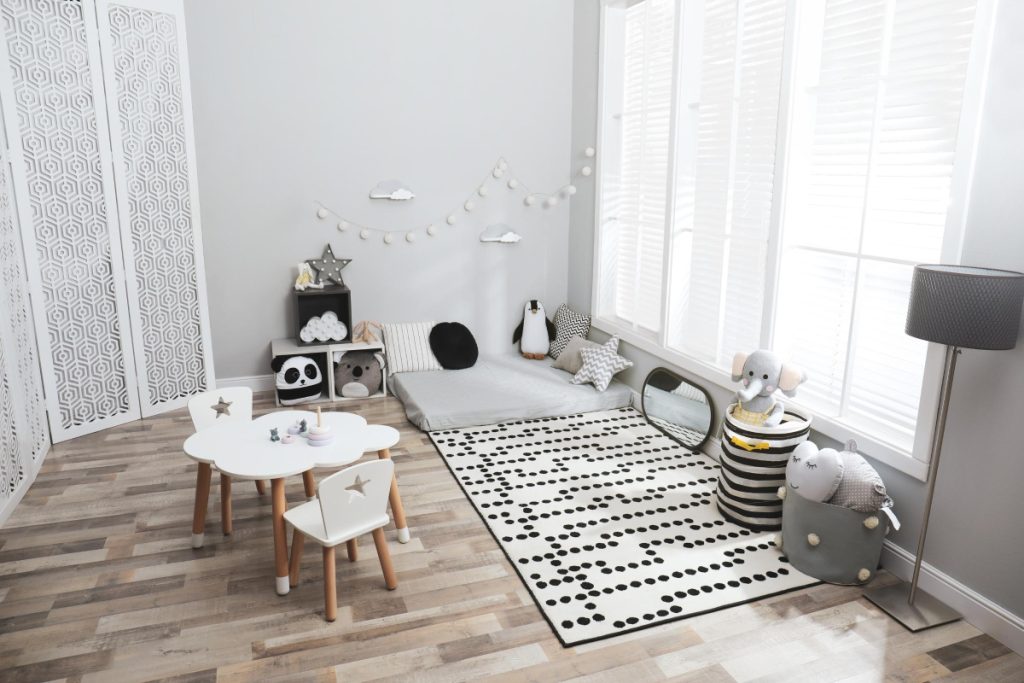
Can You Skip the Crib with a Floor Bed?
In theory, many parents claim they should be able to skip the crib by starting in a bedside bassinet and then going straight for the floor bed. In reality, while it sounds nice most people change their minds once the baby shows up…
Many parents become very anxious about safety at night and postpone the transition to a floor bed for a while. I know many parents whose kids are almost 4 and still in cribs somehow. I’m a firm believer that it all depends on the child.
With my first child, I mostly used a bassinet and he napped in a crib. He began climbing out and pulling up way before he was one, so we lowered the crib early on. He had to use a floor bed at 8 months when we moved and a new crib didn’t arrive and for him, it was the ultimate solution. I could have easily switched him at 6 months because he was developmentally advanced and we couldn’t keep him contained.
My second child was a calm baby hitting physical milestones as late as possible. He wasn’t interested in pulling up or moving up until 11 months! There was no point in even lowering the crib with him, so why would I switch him to a bed? He switched at 15 months after a few months in a floor travel crib. Every child will be ready on his own time, but I liked the option of a crib even for a few short months – even if you just get a travel bed.
Where to Buy Montessori Floor Bed?
Home For Dreams
One of the popular favorites when it comes to Montessori floor beds is manufactured by Home for Dreams. It’s a simple design that I love because it is highly effective.
The bed is made of slats and it has a railing all around to prevent the child from falling off. There is just one small section where the kid can climb out.
The Home for Dreams Montessori floor bed is designed for small children who are unsteady on their feet. I however love the design because it can be used by bigger children too. It’s a bed that will last you for a couple of years for sure.
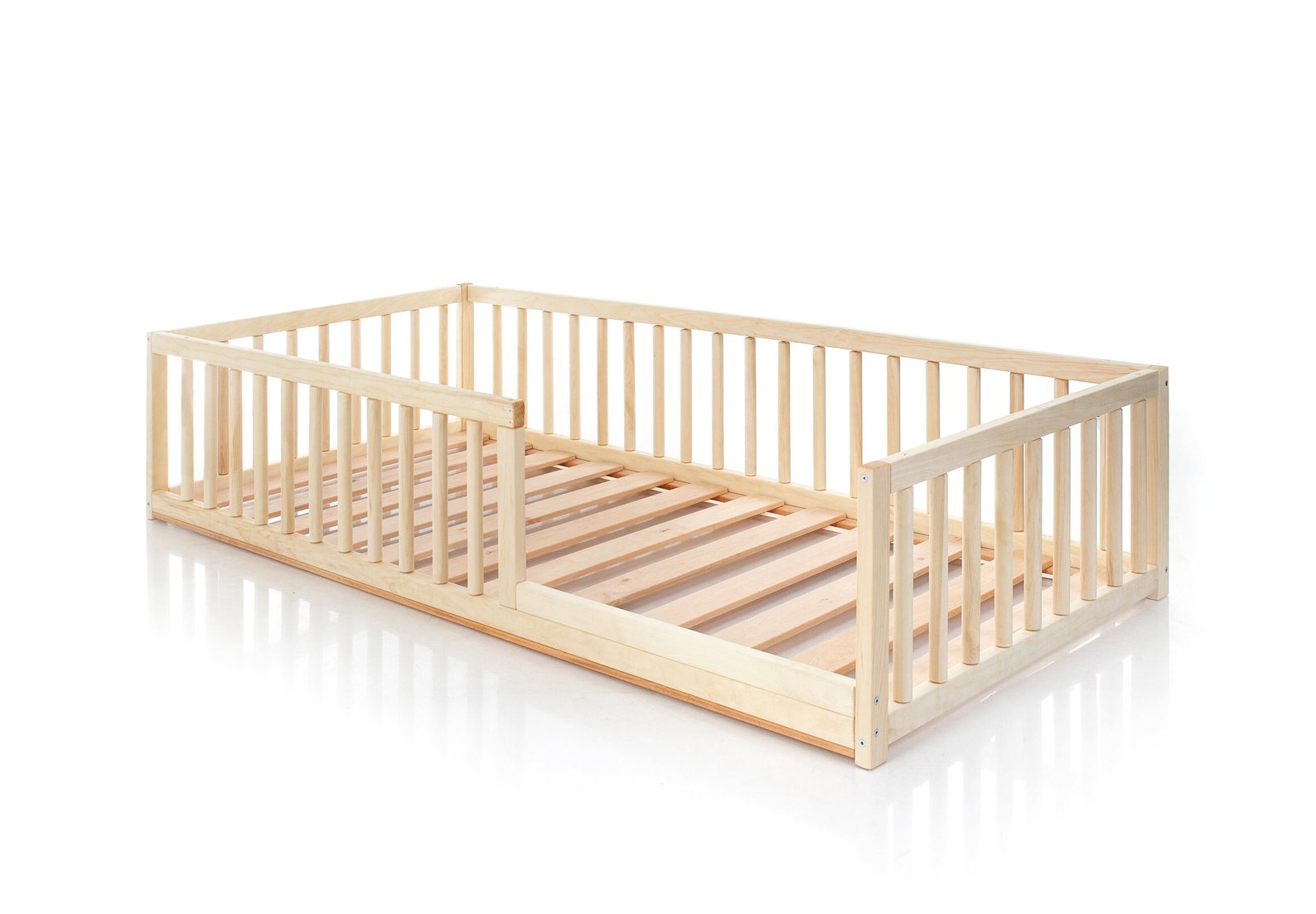
Akufa
While the Home for Dreams model is simple, practical, and great for almost all ages, Akufa brings a certain fun look to a child’s room.
I love this design because not only does it take up almost the same space as other beds in terms of horizontal room space, but it also has additional aspects of role-play that can be incorporated.
I usually transform the bed into a playpen during the day. Contrary to belief this helps with space saving since I actually use the space the bed occupies as a play area.
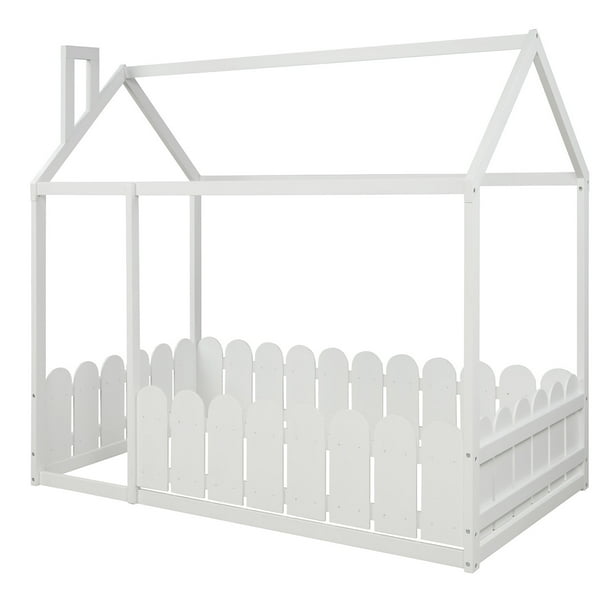
South Shore
While the South Shore may look similar to the Akufa, it has one important difference. It doesn’t have side guards which prevent the child from rolling off the edges.
The bed is also designed to fit alongside other South Shore mate beds. Since the frame is minimalistic, it allows the room to feel airy while still providing a framework for role play.
Another thing that I liked is the variety of colors that help match the bed with the existing decor in the room. You can also choose a natural wood option and paint it yourself.

Busy Wood
If you are looking for a simple practical design then BusyWood is the one you should consider. The bed is raised just half an inch – enough not to be on the floor, but not high enough to fall out.
You can stain or paint the bed to suit your needs or you can just keep it as it is. It comes in any size possible, as it’s made to order.
It’s remarkably easy to put together and the pieces fit together in neat slots. This makes the design very sturdy.
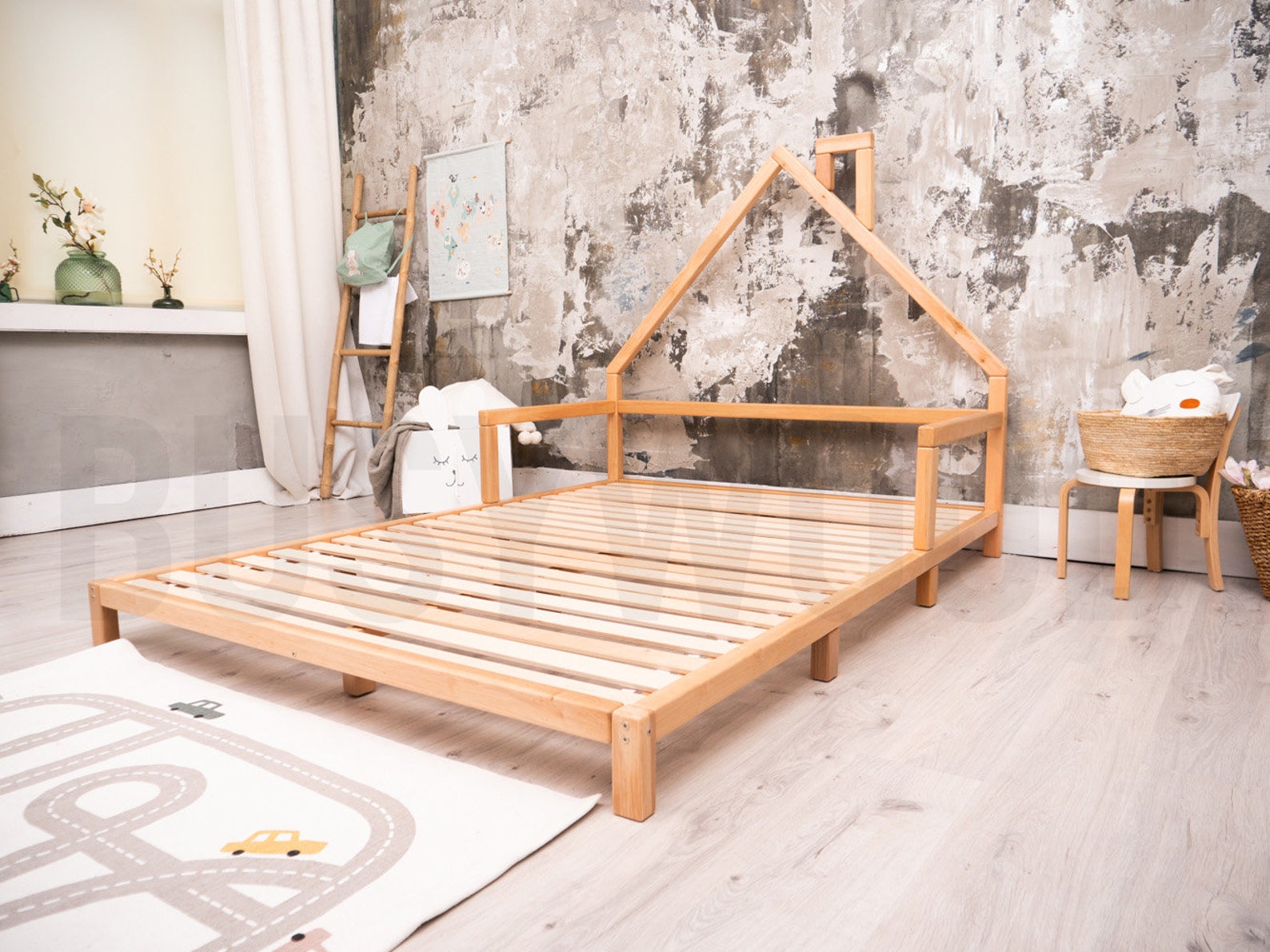
Little Seeds House Bed
While it’s not your typical floor bed, because it’s raised, if you live in very humid areas by the beach it might be best if it’s raised a bit.
It has side railings so it’s perfectly safe, but it still offers a step to get down freely.
We currently have this house bed after trying another wobbly model and this is much sturdier and works great. Installation is a charm and this will last the kid forever.

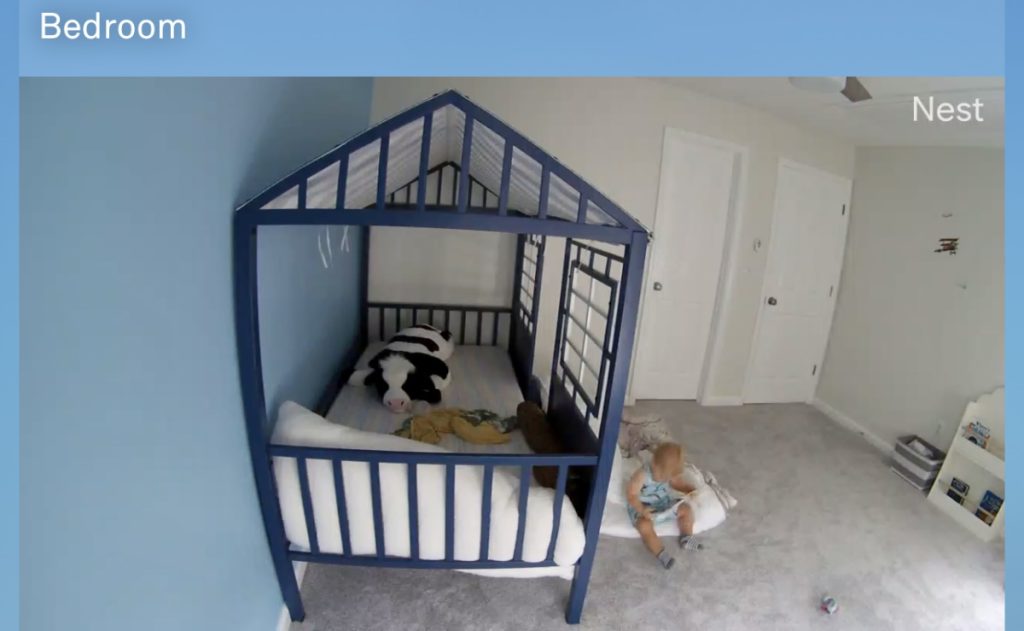
Frequently Asked Questions
What age are floor beds for?
It is said that Montessori floor beds are great for children 3 months and up. I honestly started around one. Most parents start exploring the idea of a floor bed after the child begins to crawl.
I’ll be real… my older son decided he wanted a real cool big boy car bed when he was around 2.5, so we gave his little brother his old bed when he moved.
Do You Need the Rails for the Floor Bed?
Technically, if your baby is over 6 months most sleep specialists will tell you that it’s not needed. But, for me personally, rails helped with a transition because my son was rolling all over the place and wouldn’t wake up when he rolled off the mattress. Rails weren’t bothering him but helped him stay in bed at night.
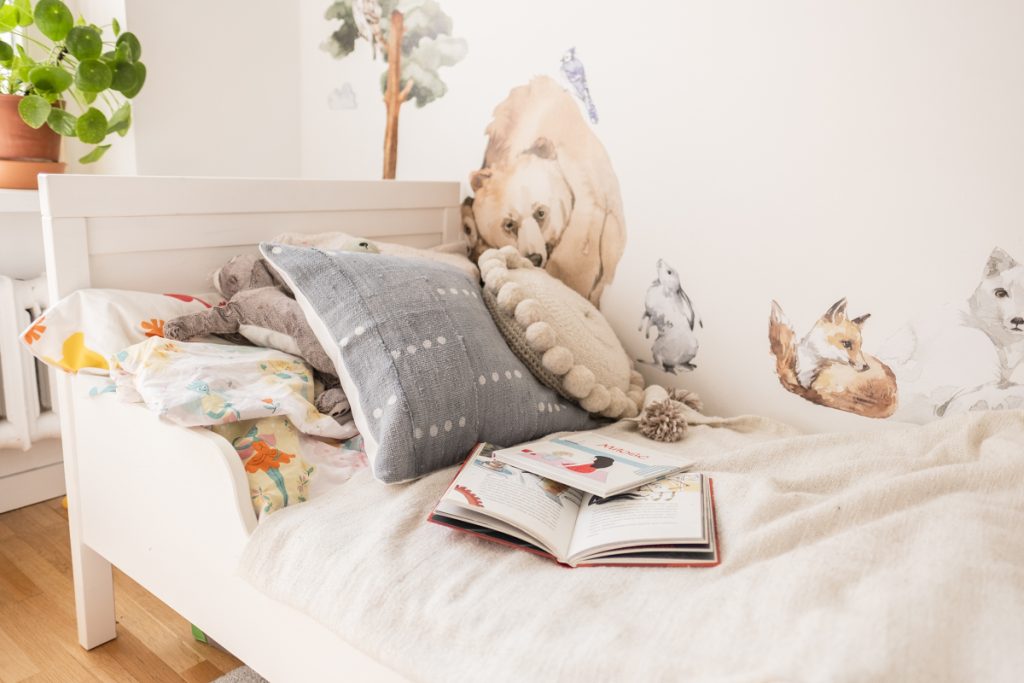
Why are Montessori beds so low?
High beds with children mean that they need to be supervised when they are small. It also means that the child cannot navigate on and off the bed on his/her own. The Montessori beds are designed low such that the height of the bed doesn’t hinder the child’s independence. In fact, low-lying beds are used by some parents almost immediately after their children start crawling.
Montessori floor bed with or without railings? How should I choose?
I think that the choice boils down to how independent your child has become. With my children, I could place them in a bed without rails around one and a half years of age. I do know that a couple of my friends have started later. I however chose not to transition to a bed without rails. So a lot is about personal preference and where your child is developmental.


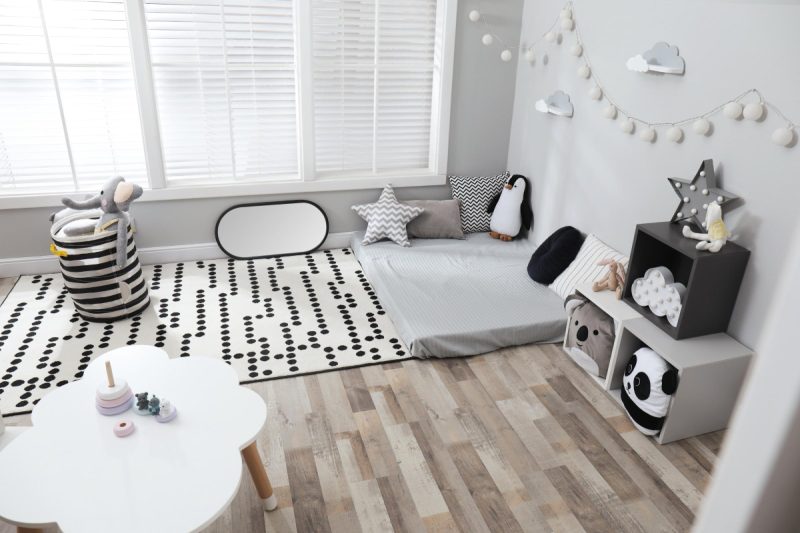

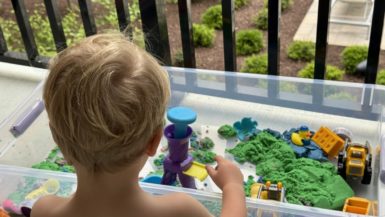

I love this idea for a Montessori floor bed for toddlers! It would be so helpful for them to have a place to sit and relax while they’re playing. I’m wondering if there are any models that are more sturdy and
I completely agree with the pros of using a Montessori floor bed for toddlers! My child loves sleeping in their floor bed and it’s so much more comfortable for them than a traditional crib. Plus, it’s great for their independence and mobility as they get older. I’m definitely considering getting one of the models you recommended for our next child!
I love the idea of a Montessori Floor Bed for toddlers! The pros you mentioned, like promoting independence and making nighttime routines easier, really resonate with me. I’m curious, though—do you have any tips for transitioning to a floor bed, especially if my toddler is used to a crib? Thanks for the insightful post!